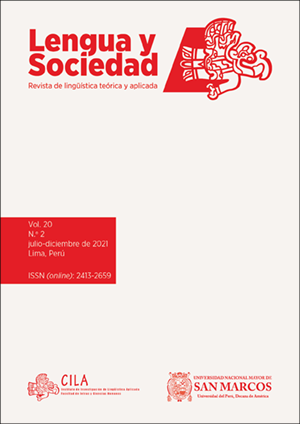Advances in the morphosyntactic description of transitivity in the Asháninka of the upper Perené
DOI:
https://doi.org/10.15381/lengsoc.v20i2.22253Keywords:
transitivity, asháninka, verbs, morphemes, objectAbstract
The traditional view of transitivity is based on the fact that the language has both transitive and intransitive verbs. On this basis, in transitive clauses there is an action of transference from a subject to an object. According to this statement, the transitive verb is the one that denotes events about the object, either an action on it or a change of state of it. However, studies subsequent to this perspective, carried out by Hopper and Thompson (1980) disagree with the above and propose that transitivity does not respond to a simple transference from the subject to the object. For the authors, transitivity is a property of languages characterized by the fulfillment of certain parameters, which indicate the greater or lesser degree of transitivity of clauses within a discursive context. The present study aims to describe the morphosyntactic characteristics that show a higher degree of transitivity in the clauses of Upper Perene Asháninka.
References
Aikhenvald, A. (2000). Transitivity in Tariana. En R. Dixon y A. Aikhenvald (Eds.), Changing Valency case studies in transitivity. Cambridge University Press.
Alonzo, A. (2013). Sustantivos y verbos en el relato asháninka Konoya ipoña Shempiri. Lengua y Sociedad, 13(1), 169-177.
Alonzo, A. (2015). Estructura de la palabra verbal en asháninka. [Estudio inédito realizado con el auspicio del VRIP-UNMSM].
Alonzo, A. (2016). Verbos transitivos en asháninka. [Estudio inédito realizado con el auspicio del VRIP-UNMSM].
Amich, J. (1975). Historia de las misiones del convento de Santa Rosa de Ocopa. Editorial Milla Batres OMF.
Campbell, L. y Grondona. V. (Eds.). (2012). The indigenous language of South America. A comprehensive guide. De Gruyter Mouton.
Casanto, E. (2008). Poñaantsi: Relatos sobre el origen ashaninca. Proyecto Pueblos Indígenas y Desarrollo Sostenible.
Castillo, A. (2017). Aspectos de la frase nominal en caquinte (campa-arawak). [Tesis de licenciatura, Universidad Nacional Mayor de San Marcos]. Repositorio de la Universidad Nacional Mayor de San Marcos.
Castillo, A. (2019). Comandos en Kakinte (Kampa-Arawak). Revista Liames Campinas, 19(1), 1-16.
Corbera, Á. (1994). Fonología e gramática do Aguaruna (Jívaro). [Tesis de doctorado, Universidad Estadual de Campinas-Brasil]. Repositorio electrónico de la Universidad de Chile. http://repositorioslatinoamericanos.uchile.cl/handle/2250/1325236.
Corbera, Á. (2017). Términos de partes del cuerpo humano en mehinacu (Arawak). Lingüística, 33(2), 55-68. http://www.scielo.edu.uy/pdf/ling/v33n2/2079-312X-ling-33-02-00055.pdf.
Comrie, B. (1989). Universales del lenguaje y tipología lingüística. Gráficas Cóndor S.A.
Dryer, M. y Haspelmath, M. (Eds.). (2015). The world atlas of language structure. Oxford University Press.
Dixon, R. y Aikhenvald, A. (1999). The Amazonian Languages. Cambridge University Press.
Dixon, R. y Aikhenvald, A. (Eds.). (2000). Changing Valency case studies in transitivity. Cambridge University Press.
Escuela Registral y RENIEC. (2019). Tesoro de nombres asháninkas. RENIEC.
García, F., Mogollón, M., Vallejos, R. y Barraza Y. (2007). Fonología del asháninka del río Pichis. Fonologías, 35-57. FORMABIAP, AIDESEP, ISPP de Loreto, Iquitos.
Givón, T. (2001). Syntax. (Volumen I). John Benjamins Publishing Company.
Gómez, E. (1991). Presente y futuro de las lenguas indígenas. Cátedra Jorge Eliécer Gaitán.
Haspelmath, M. y Sims, A. (2010). Understanding morphology (2.a ed.). Hodder Education and Hachette, UK Company.
Hopper, P. y Thompson, S. (1980). Transitivity in grammar and discourse. Language, 56(1), 251-299.
INEI. (2007). Junín. Directorio de Centros Poblados y población dispersa. Censos Nacionales XI de Población y VI de Vivienda.
Jacinto, P. y Bernales, D. (2007). Sankinarentsi. CIAMB.
Jacinto, P. (2010). El autorreconocimiento de la identidad: Asháninka vs Ashéninka. Lengua y Sociedad, 10 (1), 67-78.
Kindberg, L. (2008). Diccionario Asháninca. ILV.
Kindberg W. (1975). Formas vacías en el campa asháninca. En Datos Etnolingüísticos.
Lawrence, A. (2013). Inflectional Verbal Morphology in Nomatsigenga. [Tesis de maestría, University of Texas at Austin].
Leclerc, Charles. (1890). Arte de la lengua de los indios antis o campas. Biblioteca Americana. https://archive.org/details/artedelalenguad01adamgoog
Malvestiti, M. y Dreidemie, P. (2014). Los verbos genéricos o pro-verbos en la lengua baure (familia Arawak). III Encuentro de Lenguas Indígenas Americanas (ELIA), Libro de Actas, 197-209.
Michael, L. (2006). La incorporación nominal y los clasificadores verbales en el idioma Nanti (Kampa, Arawak, Perú). Proceedings of the Conference on Indigenous Languages of Latin America - II.
Michael, L. (2008). Nanti evidential practice: Language, Knowledge, and social action in an Amazonian society. [Tesis de doctorado, Universidad de Texas]. http://hdl.handle.net/2152/3884.
Mihas, E. (2010). Essentials of Ashéninka Perené Grammar. [Tesis de doctorado, Universidad de Wisconsin]. http://etnolinguistica.wdfiles.com/local--files/tese%3Amihas-2010/mihas_2010.pdf.
Minedu. (2013). Documento Nacional de Lenguas Originarias del Perú. (1° ed.). MINEDU.
Minedu. (2018). Lenguas originarias del Perú. (1° ed.). MINEDU.
Moreno Cabrera, J. (1991). Curso universitario de lingüística general I: teoría de la gramática y sintaxis general. Síntesis.
Nichols, J. (1986). Head-Marking and Dependent-Marking Grammar. Language, 62(1), 56-119.
Payne, D. (1991). A Classification of Maipuran (Arawakan) Languages Based on Shared Lexical Retentions. En Handbook Amazonian Languages (pp. 355-499). Desmond Derbyshire.
Payne, D., Payne, J. y Sánchez J. (2008). Morfología, fonología y fonética del Ashéninca del Apurucayali (Campa Arawak preandino) (2a ed.). ILV.
Payne, D. (2008). Diccionario Asheninca-Castellano. ILV.
Payne, J. (2008). Lecciones para el aprendizaje del idioma ashéninca. (2.° ed.). ILV.
Payne, T. (1997). Describing morphosyntax: a guide for field linguists. Cambridge University Press.
Pío Aza, J. (2005). Estudio sobre la lengua machiguenga. Ediciones Eunate S.A.
Snell, B. (1998). Diccionario Matsigenka-Castellano. ILV.
Solís, G. (2003). Lenguas en la Amazonía peruana. Programa FORTE – PE.
Swift, K. (1988). Morfología del caquinte. Ministerio de Educación-ILV.
Tallerman, M. (2015). Understanding Syntax (4.° ed.). Routledge.
Tsunoda, T. (1999). Transitivity and Intransitivity. Journal of Asian and African Studies, 57, 1-9.
Valenzuela, P. (1997). Basic verb types and argument structures in shipibo-conibo. [Tesis de maestría, University of Oregon]. http://citeseerx.ist.psu.edu/viewdoc/download?doi=10.1.1.864.6412&rep=rep1&type=pdf
Vílchez, E. (1996). Fonología del asháninka del gran pajonal con especial atención a los segmentos sibilantes. [Tesis de maestría, Universidad Nacional Mayor de San Marcos]. Repositorio de la Universidad Nacional Mayor de San Marcos.
Weiss, Gerald. (1975). Campa Cosmology: The world of a Forest Tribe in South America. Anthropological Papers of the American Museum of Natural History. http://hdl.handle.net/2246/278
Downloads
Published
Issue
Section
License
Copyright (c) 2021 Alicia Alonzo Sutta

This work is licensed under a Creative Commons Attribution 4.0 International License.
AUTHORS RETAIN THEIR RIGHTS
a. Authors retain their trade mark rights and patent, and also on any process or procedure described in the article.
b. Authors can submit to the journal Lengua y Sociedad, papers disseminated as pre-print in repositories. This should be made known in the cover letter.
c. Authors retain their right to share, copy, distribute, perform and publicly communicate their article (eg, to place their article in an institutional repository or publish it in a book), with an acknowledgment of its initial publication in the journal Lengua y Sociedad.
d. Authors retain theirs right to make a subsequent publication of their work, to use the article or any part thereof (eg a compilation of his papers, lecture notes, thesis, or a book), always indicating its initial publication in the journal Lengua y Sociedad (the originator of the work, journal, volume, number and date).



























